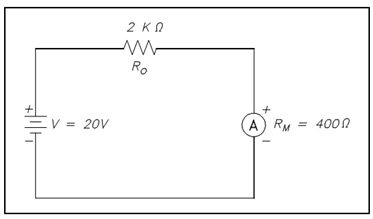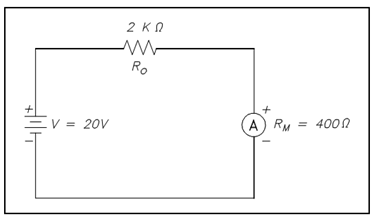Find accuracy of ammeter:
Example: An ammeter, along with a 10 mA full scale deflection and aninternal resistance of 400 ? is placed within a circuit along with a 20 V power source and a 2 K? resistor show in below figure.

Figure: Ammeter Accuracy
Find: 1. accuracy
2. %loading error
3. true current
4. measured current
1. KA= R/Ro + Rm
KA= 2000/2000 + 400
KA = 0.833 or 83.3%
2. % loading error = (1- KA) (100%)
% loading error= (1- 0.833)(100%)
% loading error=16.7%
3. Io =V/ Ro
= 20/2000
Io = 0.01A or 10mA
4. Iw=V/Ro+ Rm
= 20/2000 + 400
Iw =8.33x10-3A or 8.33mA
An ammeter within a full scale Im could be shunted along with a resistor RSH in sequence to measure current in excess of Im. A reason for shunting an ammeter is to extend the range of the ammeter and, by, measure currents higher than the original full scale value.
Through Kirchhoff's current law,
ISH = IT - Im
Because the voltage across the shunt has to be equivalent to the voltage across the ammeter; shunt resistance is calculated as given below:

Figure: Ammeter with Shunt
ISHRSH = ImRm
RSH = ImRm/ISH
RSH = ImRm/IT - Im
Thus, the input resistance of a shunted ammeter is associated to the meter and shunt resistance. Given Equation (14-8) is a mathematical representation of this relationship.
NOTE: Whenever computing accuracy for a shunted ammeter, use R 1m within place of Rm.
R 1m = RmRSH /Rm + RSH (14-8)
Equation (14-9) is a mathematical representation of the relationship among input voltage and current to the ammeter and the value of input resistance.
R 1m =Vin/Iin + ImRm/IT (14-9)